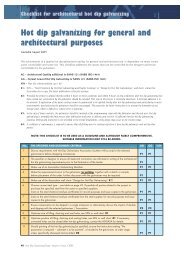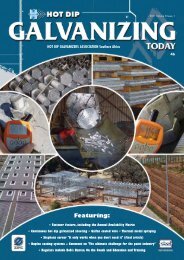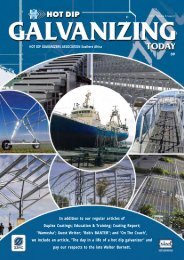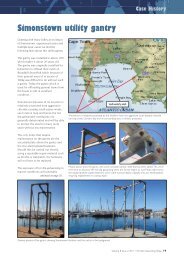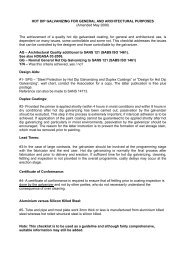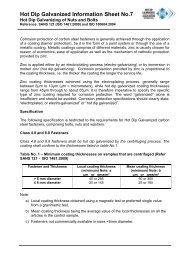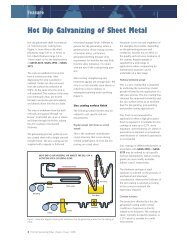Fasteners - hdgasa
Fasteners - hdgasa
Fasteners - hdgasa
You also want an ePaper? Increase the reach of your titles
YUMPU automatically turns print PDFs into web optimized ePapers that Google loves.
<strong>Fasteners</strong><br />
structures, has been replaced by the 2008 version. Light<br />
oiling as an accepted lubrication has now been removed<br />
in the new standard because of the inconsistent outcome<br />
and poor lubrication quality. For example, to attain the<br />
same pre load of 220kN for a M24 grade 10.9 bolt, a<br />
torque of 800Nm is required when lubricated with<br />
molybdenum disulphide, whereas with oil, 1100Nm<br />
torque is required.<br />
Lack of lubrication would be a problem particularly in hot<br />
dipped galvanized applications. It has been demonstrated<br />
that whereas the coefficient of friction starts at 0.19 at the<br />
commencement of tightening, once preload is being<br />
achieved, this has increased to 0.27 as a result of the<br />
galling of the soft galvanized surface. Therefore the<br />
required tension in the bolt will not be achieved, that is<br />
the bolt will effectively not be holding plates in a spring<br />
pre load condition. Under this un-lubricated condition, it<br />
has also been found that the torsional stress can result in<br />
the failure of the bolt at around the required pre load,<br />
which is only 70% of the yield point before a bolt should<br />
start deforming.<br />
to? Torque is a misnomer because it is the pre load or<br />
tension in the bolt which is the goal. It has already been<br />
demonstrated above that under different coefficient<br />
conditions, different torque is required. It is interesting<br />
that EN 1090-2:2008, the European equivalent for DIN<br />
18800-7, goes further by not specifying the torque values<br />
at all. These values have to be established by testing bolt<br />
assemblies themselves to ascertain the torque required to<br />
obtain the specified preloads. It is also a daily<br />
requirement on site for erectors to verify the calibration of<br />
the wrenches in use to ensure that their torque values<br />
match the pre load required. This is done by testing three<br />
bolts for the diameter of bolt to be used on that day.<br />
Finally, a further requirement of fastener manufacturers is<br />
to conduct training to erectors explaining some of the<br />
above. In addition to topics covered, it is also generally a<br />
good idea to address installation best practice. This is<br />
preventative training to ensure that reckless installation is<br />
not creating a condition that may only manifest many<br />
months after initial installation.<br />
We have mentioned torque a few times and this is<br />
generally the “talk” on site; what do we torque the bolts<br />
R J Pietersma, Chairman, South African <strong>Fasteners</strong> Manufacturers<br />
Association.<br />
Volume 9 Issue 1 2012 Hot Dip Galvanizing Today 15



